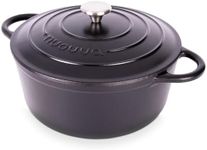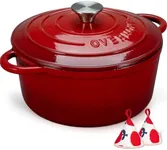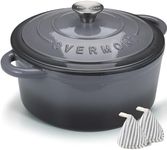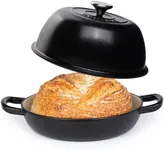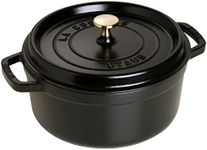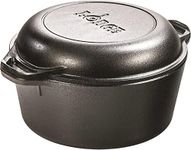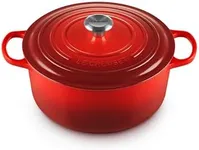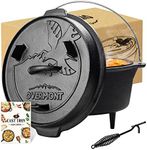Buying Guide for the Best Dutch Ovens
Choosing the right Dutch oven can greatly enhance your cooking experience, as these versatile pots are perfect for a variety of cooking methods, including braising, baking, and simmering. When selecting a Dutch oven, consider the size, material, weight, and additional features that will best suit your cooking needs and lifestyle. Understanding these key specifications will help you make an informed decision and ensure that your Dutch oven becomes a cherished tool in your kitchen.SizeThe size of a Dutch oven is crucial because it determines how much food you can cook at once. Dutch ovens are typically measured in quarts, with common sizes ranging from 3 to 7 quarts. A smaller Dutch oven (3-4 quarts) is ideal for individuals or couples, while a medium size (5-6 quarts) suits a small family. Larger sizes (7 quarts and above) are perfect for big families or those who frequently entertain guests. Consider the number of people you usually cook for and the types of dishes you plan to make when choosing the size.
MaterialDutch ovens are primarily made from cast iron, which is known for its excellent heat retention and even cooking. Some are coated with enamel, which makes them easier to clean and prevents rusting. Bare cast iron requires seasoning to maintain its non-stick properties and prevent rust. Enamel-coated Dutch ovens are great for those who prefer low-maintenance cookware, while bare cast iron is favored by those who enjoy the traditional cooking experience and don't mind the extra care. Choose based on your preference for maintenance and cooking style.
WeightThe weight of a Dutch oven is important because it affects how easy it is to handle, especially when full of food. Cast iron Dutch ovens are generally heavy, which can be a consideration if you have difficulty lifting heavy objects. Lighter options are available, but they may not offer the same heat retention properties. If you prioritize ease of handling, look for a lighter model, but if you value cooking performance, a heavier Dutch oven might be worth the extra effort.
ShapeDutch ovens come in round and oval shapes. The shape can influence how well the pot fits on your stovetop and in your oven. Round Dutch ovens are more common and fit well on most stovetops, making them versatile for a variety of cooking tasks. Oval Dutch ovens are ideal for cooking larger cuts of meat, like roasts, as they provide more surface area. Consider the types of dishes you plan to cook and your kitchen setup when deciding on the shape.
Lid DesignThe lid design of a Dutch oven can impact its cooking performance. A tight-fitting lid is essential for retaining moisture and heat, which is crucial for slow-cooking and braising. Some lids have self-basting spikes on the underside, which help to evenly distribute moisture back onto the food. If you plan to use your Dutch oven for slow-cooking or braising, look for a model with a well-designed lid that ensures a good seal and promotes even cooking.

